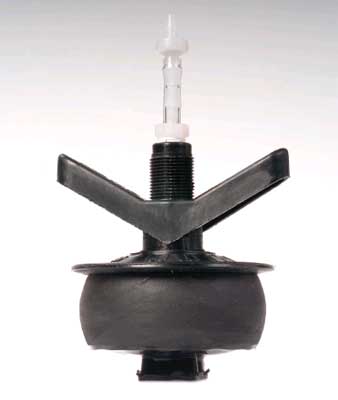
Gary Kees Project Leader
The backpack sprayer is one of the most effective pieces of equipment in the fight against noxious weeds, especially in areas that are not accessible by vehicles, tractors, ATVs, or UTVs. Backpack sprayers work well because the operator can pump them to maintain nozzle pressure while walking at a steady pace. Backpack sprayers also hold more herbicide solution than unwieldy hand-held sprayers.
Highlights...
- Backpack sprayers can be uncomfortable
to wear, especially if fluid sloshes and
leaks on the applicator.
- A new harness for two popular models
of sprayers was developed with a
well-padded back panel, waist belt, and
shoulder harness yoke.
- Drawing MTDC–1065 shows how to construct the backpack harness. Patterns are included. Drawing MTDC–1074 shows how to modify a rubber plug to prevent a sprayer's tank lid from leaking. Both drawings are available from MTDC.
Toting a backpack sprayer with 4 gallons of herbicide sloshing in the tank is not ideal because the sprayer may leak, straps often are poorly designed, and back supports may be uncomfortable. The Missoula Technology and Development Center (MTDC) purchased three backpack sprayers (Solo 425, SP Systems SP0, and D.B. Smith Field King Deluxe), figure 1. Backpack sprayer issues covered in this tech tip include:
- Applicator comfort
- New harness designs
- Leakage problems and sprayer maintenance
- Constant flow regulators
- Sprayer specifications (Solo, SP Systems, and D.B. Smith sprayers)
- Sprayer calibration references
- Vendor information

Figure 1—The Solo 425, SP Systems SP0, and D.B. Smith Field King
Deluxe
backpack sprayers were evaluated for comfort and leakage by
MTDC.
Most backpack sprayers can hold up to 4 gallons of herbicide solution weighing about 33 pounds. This weight could be carried comfortably in a standard backpack, but poorly designed straps and back supports and leaky tank lids can make backpack sprayers miserable to carry and messy to use.
Backpack sprayers typically come standard with a molded plastic tank that fits against the applicator's back and narrow, lightly padded straps that carry the weight of the sprayer on the applicator's shoulders (figure 2). This might be okay for applicators carrying one or two tank loads, but not for field employees spraying all day in rough terrain. Some strap and waist belt upgrades are available, but even the upgrades could be improved.

Figure 2—The narrow straps and hard plastic back supports on
commercial
backpack sprayers are not comfortable for field employees who may
carry
up to 4 gallons of liquid in the sprayers throughout the day.
MTDC developed a new harness that can attach to either a Solo or SP Systems backpack sprayer, but not to the D.B. Smith Field King sprayer, which has a 3-point harness attachment. The new harness design includes a well-padded back panel, waist belt, and shoulder harness yoke (figure 3). The yoke portion of the harness comes from an existing firefighter pack design. The drawing MTDC–1065 "Backpack Sprayer Harness" is available from MTDC. Drawings include full-size patterns. The harnesses themselves are not available through MTDC, but a local industrial sewing shop such as a tent, awning, or canvas shop should be able to assemble the harness from the patterns.

Figure 3—A new backpack sprayer harness designed
by MTDC has a
padded back, a shoulder harness
yoke, and
a wide, padded waist belt. The
modified
plug is shown
installed
in the sprayer's tank.
Benchmark Manufacturing in Helena, MT, will be fabricating the new backpack sprayer harness, which is expected to cost about $45. Benchmark's address and phone number are listed in the "Vendor Information" section.
Leakage Problems and Sprayer MaintenanceFluid leaking from backpack sprayers is a common problem. Leaks may come from the lid seal, the vent, pump, or wand. Often, leaks are caused by improper or no maintenance. Lid seals and rubber vent seals should be lubricated with silicone grease or petroleum jelly. Damaged or hardened lid seals and vent seals should be replaced. Leaking pumps or wands should be rebuilt using the manufacturer's repair kits and recommended repair and maintenance procedures.
A few hours of maintenance spent before the spraying season prevent lost time in the field and reduce herbicide leaks. Remember to clean the tanks thoroughly after spraying. Run plenty of clean water through the pump and wand. Keep all wand and tank strainers clean. Do not store herbicide solutions in the tank.
Poor manufacturing quality can contribute to leaking. Two of the sprayers that were evaluated had very rough edges around the opening of the tank and did not seal well. After the edges of the opening were smoothed out, the tank's lid made a better seal. The opening of one of the tanks was slightly egg shaped, which made it nearly impossible to seal the lid.
MTDC performed a simple leak evaluation by filling the backpack sprayers with water and laying them on their sides (figure 4). The D.B. Smith Field King Deluxe began leaking at once with a steady drip out the lid vent and the seal. The Solo 425 leaked about 1 drop every 30 seconds out the vent. The SP Systems SP0 sprayer did not leak. Later a surfactant was added to the water, increasing leakage from the D.B. Smith Field King Deluxe and Solo 425 sprayers and contributing to a small amount of leakage out of the SP Systems SP0 sprayer. None of the pumps, wands, or hoses leaked during our evaluation.

Figure 4—Poorly fitted seals and leaking lid vents may allow herbicides
to
drip onto the applicator. When the three backpack sprayers being
evaluated
were laid on their sides, all of them leaked fluid from the
lids and vents.
A rubber pipe plug can be modified slightly and used to tightly seal the top of a Solo sprayer or other spray tanks, such as those used on an ATV (figure 5). The plug should be drilled and tapped so a one-way check valve can be installed. A diagram with information on materials and directions for making the plug are shown in figure 6 (drawing MTDC– 1074). The plug's components cost about $13.
The new harness also helps reduce leakage. Applicators are less likely to shift the weight of the sprayer on their back, so the contents of the tank are less likely to be sloshing around.

Figure 5—Replacing the original backpack sprayer's cap
with
a rubber pipe
plug fitted with a one-way check valve
to allow air into the sprayer helped
reduce the amount of
leakage. A similarly configured pipe plug also could
replace the lids of some ATV or UTV spray tanks.

Figure 6—A rubber pipe plug can be modified slightly and used to tightly seal the top of a
Solo sprayer or other spray tanks such as those used on an ATV.
For a longer description click here.
A CFValve constant flow regulator attaches to the end of the spray wand. The constant flow regulator helps maintain a constant application rate, reduces drift, and decreases the amount of pumping required. The CFValve (figure 7) is available for several different brands of backpack sprayers and comes in models with different colors indicating different pressures. It costs about $20. One disadvantage of using the CFValve is that it must be removed during cleaning to fully relieve pressure from the wand.

Figure 7—A CFValve constant flow regulator, attached between the
wand
and spray nozzle, helps maintain a constant application rate and
reduces the
amount of pumping required when spraying herbicides.
| Manufacturer | SP Systems | Solo | D.B. Smith |
|---|---|---|---|
| Model No. | SP0 | 425 | Field King Deluxe |
| Capacity (gallons) | 4 | 4 | 4 |
| Pump type | Multifunction | Piston | Piston |
| Maximum pressure (psi) | 150 | 90 | 160 |
| Gasket/seal/O-ring type | Viton/Nytril | Viton | Viton |
| Strap configuration | Shoulder | Shoulder | Shoulder/Waist |
| Dry weight (pounds) | 13 | 9.5 | 10 |
| Price (from Gempler's) | $170 | $95 | $100 |
| Pump strokes* | 6 | 4 | 3 |
| Unregulated spray time** | 17 | 22 | 12 |
| Regulated spray time*** | 21 | 27 | 18 |
* Pump strokes (up once, down once is a single stroke) required to raise the wand pressure from 21 to 60 pounds per square inch.
** Unregulated spray time is the time in seconds it takes for wand pressure to drop from 60 to 21 pounds per square inch while spraying without
pumping and without a CFValve constant flow regulator.
*** Regulated spray time is the amount of time in seconds it takes to drop wand pressure from 60 to 21 pounds per square inch while spraying without
pumping when using a CFValve constant flow regulator.
Applying herbicides at recommended rates with a backpack sprayer is very difficult. The applicator's speed, the height of the spray nozzle, the type and adjustment of the nozzle, the amount of herbicide added to the tank, and wand pressure all affect the rate at which herbicide is applied. Often, more herbicide is applied than permitted by the label, wasting money and increasing the applicator's and the environment's exposure to chemicals. Several good references on calibrating and operating backpack sprayers include:
Single-Nozzle Backpack or ATV Sprayer Calibration
Florida Cooperative Extension Publication SS– AGR–108 by B.A. Sellers, J.A. Ferrell, C.R. Rainbolt, and G.E. MacDonald Available at http://edis.ifas.ufl.edu/WG217 (HTML file for viewing) or http://edis.ifas.ufl.edu/pdffiles/WG/WG21700.pdf (Acrobat file for printing)
Calibrating and Using Backpack Sprayers
Pacific Northwest Extension Publication 320 by C.G. Landgren Available at http://library.ndsu.edu/tools/dspace/load/?file=/repository/bitstream/handle/10365/3068/335lan87.pdf?sequence=1 (HTML file for viewing) or http://caribeturf.com/yahoo_site_admin/assets/docs/http_extensionoregonstateedu_catalog_html_pnw_pnw320.23053047.pdf(Acrobat file for printing)
Calibrating Hand-Held and Backpack Sprayers for Applying Pesticides
Virginia Cooperative Extension Publication 456–502 by S.M. Zedaker Available at http://www.ext.vt.edu/pubs/forestry/456-502/456-502.html (HTML file for viewing) or http://www.ext.vt.edu/pubs/forestry/456-502/456-502.pdf (Acrobat file for printing)
Vendor InformationThe suppliers of materials discussed in this tech tip are listed below:
Harness for Backpack Sprayers
Benchmark Manufacturing
1325 Helena Ave.
Helena, MT 59601
Phone: 800–735–8632
Fax: 406–449–6200
Web site: http://benchmarkmfg.com
SP Systems SP0 Sprayer
SP Systems, LLC
P.O. Box 7098
Santa Monica, CA 90406
Phone: 800–457–3440
Fax: 310–449–6912
Web site: http://www.spsystemsllc.com/
Technical information: http://www.spsystemsllc.com/professional/sp0.html
Solo 425 Sprayer
Solo
5100 Chestnut Ave.
Newport News, VA 23605
Phone: 757–245–4228
Fax: 757–245–0800
Web site: http://www.solousa.com
Technical information: http://www.solousa.com/store/flypage/backpack_sprayers/4525%99_backpack_sprayer.htm
D.B. Smith Field King Deluxe Sprayer
D.B. Smith
23 Garden St.
Mills, NY 13417
Phone: 315–736–0037
Fax: 315–768–4220
Web site: http://www.dbsmith.com
Technical information: http://www.dbsmith.com/products/backpacksprayers.php
CFValve
Gempler's
P.O. Box 44993
Madison, WI
53744-4993
Phone: 1-800-382-8473
Web site:http://www.gemplers.com/product/163124/CFValve-Constant-Flow-Valve
Pesticide Precautionary Statement
This publication does not contain recommendations for the use of pesticides, nor does it imply that the uses discussed here have been registered. All uses of pesticides must be registered by appropriate State and/or Federal agencies before they can be recommended.
CAUTION: Pesticides can be injurious to humans, domestic animals, desirable plants, and fish or other wildlife—if they are not handled or applied properly. Use all pesticides selectively and carefully. Follow recommended practices for the disposal of surplus pesticides and pesticide containers.

Gary Kees joined MTDC in 2002 as a project leader. Gary works in the reforestation and nursery, forest health, fire, and GPS programs. His current projects involve laser guidance systems, ATV and backpack sprayers, nursery seeders, and remote weather stations. Gary, who has a degree in mechanical engineering from the University of Idaho, worked for 10 years as a mechanical and structural engineer, project manager, and engineering group leader for the Monsanto Co. in Soda Springs, ID.
Additional single copies of this document may be ordered from:
USDA Forest Service
Missoula Technology and Development Center
5785 Hwy. 10 West
Missoula, MT 59808–9361
Phone: 406–329–3978
Fax: 406–329–3719
E-mail: wo_mtdc_pubs@fs.fed.us
Electronic copies of MTDC's documents are available on the Internet at:
For additional information about backpack sprayers, contact Gary Kees at MTDC:
Phone: 406–829–6753
Fax: 406–329–3719
E-mail: gkees@fs.fed.us
Forest Service and Bureau of Land Management employees can search a more complete collection of MTDC's documents, CDs, DVDs, and videos on their internal computer networks at:

